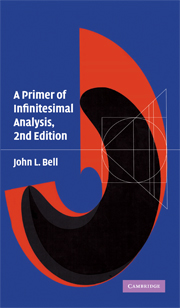Aristotle, (1980). Physics, Vol. II. Cambridge, MA: Harvard University Press.
Banach, S. (1951). Mechanics (trans. E. J. Scott). Warszawa: PWN.
Baron, M. E. (1969). The Origins of the Infinitesimal Calculus. Oxford: Pergamon Press.
Barr, M. and Wells, C. (1985). Toposes, Triples and Theories.Berlin: Springer-Verlag.
Bell, J. L. (1986). From absolute to local mathematics. Synthese, 69, 409–26.
Bell, J. L. (1988a). Infinitesimals. Synthese, 75, 285–315.
Bell, J. L.(1988b). Toposes and Local Set Theories.Oxford: Clarendon Press.
Bell, J. L. (1995). Infinitesimals and the continuum. Mathematical Intelligencer, 17(2), 55–7.
Bell, J. L. and Machover, M. (1977). A Course in Mathematical Logic.Amsterdam: North-Holland.
Bell, J. L. (2005a). The Continuous and the Infinitesimai in Mathematics and Philosophy. Milano: Polimetrica.
Bell, J. L.(2005b). Continuity and Infinitesimals. Stanford Encyclopedia of Philosophy.
Boyer, C. B. (1959). The History of the Calculus and its Conceptual Development.New York: Dover.
Brouwer, L. E. J. (1964). Intuitionism and formalism. In Philosophy of Mathematics, Selected Readings, eds Benacerraf, P. and Putnam, H.. Oxford: Blackwell.
Cascuberta, C. and Castellet, M., eds (1992). Mathematical Research Today and Tomorrow: Viewpoints of Six Fields Medallists.Berlin: Springer-Verlag.
Courant, R. (1942). Differential and Integral Calculus. London: Blackie.
Dubuc, E. (1979). Sur les modeles de la geometrie differentielle synthetique. Cahiers de Topologie et Geometrie Differentielle, XX-3, 231–79.
Dummett, M. (1977). Elements of Intuitionism.Oxford: Clarendon Press.
Freyd, P. J. and Scedrov, A. (1990). Categories, Allegories.Amsterdam: North-Holland.
Gibson, G. (1944). An Introduction to the Calculus.London: Macmillan.
Goldblatt, R. I. (1979). Topoi: The Categorial Analysis of Logic.Amsterdam: North-Holland.
Heyting, A. (1971). Intuitionism: An Introduction.Amsterdam: North-Holland.
Hohn, F. E. (1972). Introduction to Linear Algebra.New York: Macmillan.
Johnstone, P. T. (1979). Topos Theory.London: Academic Press.
Kant, I. (1964). Critique of Pure Reason.New York: Macmillan.
Kleene, S. C. (1952). Introduction to Metamathematics.Amsterdam: North-Holland and New York: Van Nostrand.
Kock, A. (1977). A simple axiomatics for differentiation. Mathematica Scandinavica, 40, 183–93.
Kock, A.(1981). Synthetic Differential Geometry. Cambridge: Cambridge University Press. (Second edition, 2006)
Lambek, J. and Scott, P. J. (1986). Introduction to Higher-Order Categorical Logic.Cambridge: Cambridge University Press.
Lavendhomme, R. (1987). Lecons de Geometrie Synthetique Differentielle Naive.Louvain-La-Neuve: Institut de Mathematique.
Lavendhomme, R.(1996). Basic Concepts of Synthetic Differential Geometry.Dordrecht: Kluwer.
Lawvere, F. W. (1979). Categorical dynamics. In Topos Theoretic Methods in Geometry, Aarhus Math. Inst. Var. Publ. series 30.
Lawvere, F. W. (1980). Toward the description in a smooth topos of the dynamically possible motions and deformations of a continuous body. Cahiers de Topologie et Geometrie Difféentielle, 21, 377–92.
Lawvere, F. W. and Schanuel, S. (1997). Conceptual Mathematics: A First Introduction to Categories. Cambridge University Press.
Lane, Mac S. (1971). Categories for the Working Mathematician.New York: Springer-Verlag.
Lane, Mac S. and Moerdijk, I. (1992). Sheaves in Geometry and Logic: A First Introduction to Topos Theory.New York: Springer-Verlag.
McLarty, C. (1988). Defining sets as sets of points of spaces. Journal of Philosophical Logic, 17, 75–90.
McLarty, C. (1992). Elementary Categories, Elementary Toposes.Oxford: Clarendon Press.
Misner, C., Thorne, K., and Wheeler, J. (1972). Gravitation. Freeman.
Moerdijk, I. and Reyes, G. E. (1991). Models for Smooth Infinitesimal Analysis.New York: Springer-Verlag.
Peirce, C. S. (1976). The New Elements of Mathematics, Vol. III, ed. Eisele, C.. Atlantic Highlands, NJ: Humanities Press.
Rescher, N. (1967). The Philosophy of Leibniz.Englewood Cliffs, NJ: Prentice-Hall.
Robinson, A. (1966). Non-Standard Analysis.Amsterdam: North-Holland.
Russell, B. (1937). The Principles of Mathematics, 2nd edn. London: George Allen and Unwin Ltd.
Spivak, M. (1979). Differential Geometry, 2nd edn. Berkeley: Publish or Perish.
Dalen, D. (1995). Hermann Weyl's intuitionistic mathematics. Bulletin of Symbolic Logic, 1(2), 145–69.
Wagon, S. (1985). The Banach–Tarski Paradox.Cambridge: Cambridge University Press.
Weyl, H. (1921). Uber die neue Grundlagenkrise der Mathematik. Mathematische Zeitschrift, 10, 39–79.
Weyl, H.(1922). Space–Time–Matter.New York: Dover.
Weyl, H. (1940). The ghost of modality. In Philosophical Essays in Memory of Edmund Husserl. Cambridge, MA: Harvard University Press.
Weyl, H. (1987). The Continuum: A Critical Examination of the Foundation of Analysis (transl. S. Pollard and T. Bole). Philadelphia: Thomas Jefferson University Press.



